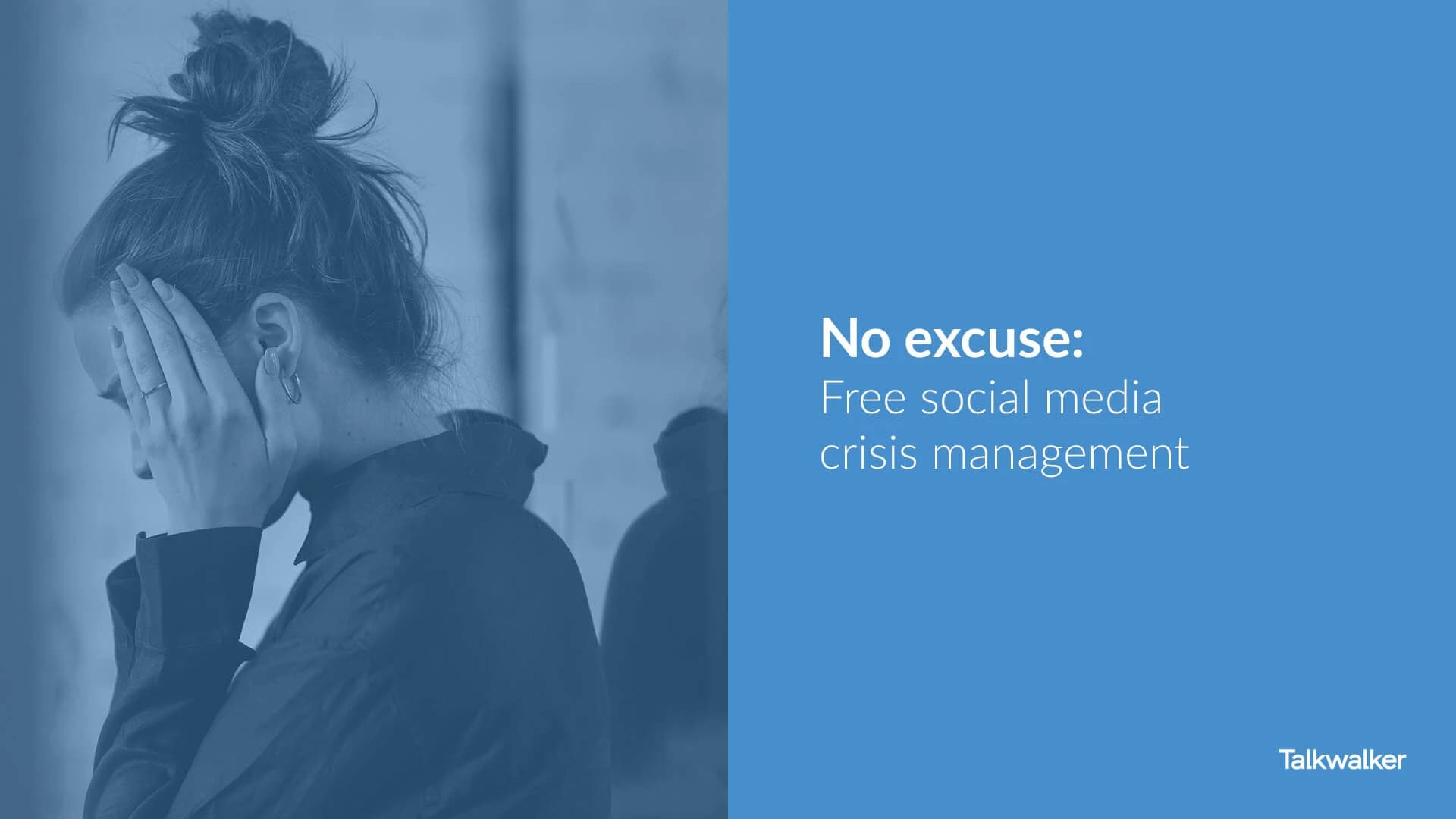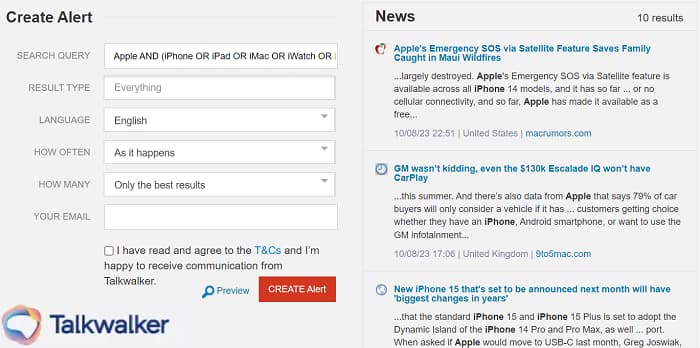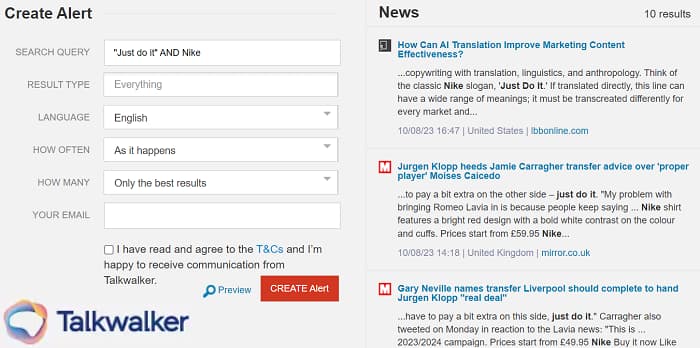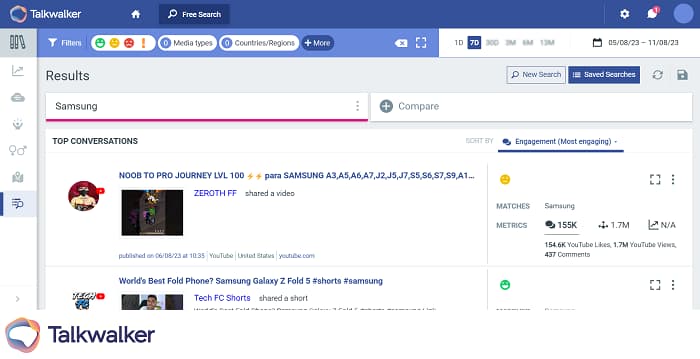No excuse: Free social media crisis management
Social media crisis management requires meticulous research, preparation, and planning. This blog provides simple steps and free tools to help.
April 6, 2020

- 1. Monitor your brand mentions
- 2. Define a social media crisis
- 3. Build a social media crisis communication policy
- 4. Check all scheduled posts
- 5. Manage internal communication
- 6. Create a dedicated crisis response page
- 7. Respond on social media
- 8. Involve executives if necessary
- 9. Write comprehensive documentation
- Social media crisis management example
- Start your social media crisis management today
- Frequently asked questions
As a social media manager, readiness for a crisis is essential. Social media crisis management helps mitigate risks and limit the damage. Below are nine easy steps to help you manage a crisis using Talkwalker’s free tools. Plus a successful social media crisis management example.
This blog is part of our social media crisis hub. Check it out to discover more resources and insights to help you plan or manage a brand crisis.
1. Monitor your brand mentions
One critical aspect of crisis management is early detection. Recognizing a situation and responding quickly can prevent a minor issue from escalating into a full-blown crisis. Setting up Talkwalker Alerts for your keywords is an efficient method.
Here are some best practices to make alert setup easier:
Use Boolean operators to narrow down your searches
Broad search terms may yield many irrelevant results. To narrow your results, include these three common Boolean operators:
AND: Results include both keywords.
AND NOT: Results exclude the second keyword.
OR: Results include either of the keywords.
Brackets: These can help in making more complex searches.
Example: Don’t set up an alert for Apple. Instead, try Apple AND (iPhone OR iPad OR iMac OR iWatch OR MacBook).

Set up Alerts to monitor brand mentions to prevent social media crises
Set alerts for taglines – Sometimes brand taglines overshadow the brand name. For example, Nike’s “Just Do It” or Coca-Cola’s “Open Happiness.” Setting an alert for taglines can be beneficial in these cases. Don’t forget to use quotation marks when setting alerts for taglines.

Don’t forget your company’s executive team
Don't overlook the key executives and media spokespersons within your company. After all, your leaders' reputation directly affects the company's reputation.
2. Define a social media crisis
A few negative comments online don't constitute a crisis. It's normal for people to occasionally express disappointment. But things can blow up. And even the best brands can face a crisis (there are plenty of social media crisis examples here).
A situation escalates to a social media crisis if:
It elicits strong negative emotions,
It poses a risk of lasting damage to your brand reputation,
It creates confusion among your customers, stakeholders, clients, and employees,
It holds the potential to go viral.
To stay ahead of potential crises, companies should identify a set of predefined topics, or "red flags”, that could expose them. This involves a thorough analysis of events both inside and outside the company, encompassing online and offline occurrences.
Identify what previously sparked a crisis for your brand. Also, consider the issues that led to industry-wide crises or affected your competitors.
Understanding these situations and subjects will give you valuable insights. Enabling you to craft data-driven responses to future conversations that might otherwise escalate.
This blog covers more about what is not an example of a social media crisis.
3. Build a social media crisis communication policy
A social media crisis plan is essential as a guideline for crisis communication. It ensures prompt response to issues, cutting the need for debates on handling situations or waiting for approval from senior management. Here's what an action plan should include:
Channel-specific social media strategy
Social media channels are distinct, with varying communication formats. LinkedIn is more professional, whereas Twitter and Facebook tend to be more casual. The policy document should emphasize these differences, ensuring that the communication team adheres to content guidelines even during a crisis. For more details on the different types of messaging for different channels, download this Social media messaging checklist.
Audience specific policies
Addressing a dissatisfied customer requires a different approach than responding to a journalist. Your plan must cover specific strategies for engaging with different audience segments. With clear instructions on how to communicate with each type and who will be responsible for doing so.
No-go topics
It's critical to enumerate forbidden topics within your social media crisis communication policy. These could include contentious issues such as politics, rumors, sex, and religion.
By identifying each off-limits subject, you ensure that the communication team knows what to avoid in their messaging.
Define Service Level Agreement (SLA)
SLA plays a vital role in crisis communication. An unaddressed issue can escalate into a crisis if left unresolved for too long. It's essential to define an SLA tailored to the specific issue at hand.
Social media crisis communication team
Assign a communication specialist to manage each product, segment, or topic, taking ownership of the process. Include a leadership position for potential communication with the media. Include the names and contact details of all team members in the document.
Line of approval
The primary aim of a social media crisis communication policy is to ensure swift action with minimal bureaucracy. But some topics may need multiple approvals across different management levels. Your document must delineate the approval process for each topic, enabling communication managers to know who to contact and maintain efficiency.
4. Check all scheduled posts
As you manage a social media crisis, your audience will scrutinize every action you take.
It's crucial to appear neither impassive nor thoughtless.
If a crisis arises, your first step should be to review all scheduled posts to ensure they’re correct. You should pause any posts that are unfitting. That includes promotional content, contests, and discount campaigns.
Once the situation is under control, you can resume these activities.
In the meantime, your social media team should focus on monitoring ongoing conversations. You can monitor brand mentions from the last 7 days using Talkwalker’s Free Social Search tool. This valuable social listening resource provides brand insights in real time. Helping you to respond with sensitivity to the unfolding situation.

5. Manage internal communication
As a crisis occurs, it's essential to keep employees and other stakeholders informed. Misinformation can spread quickly, escalating the situation and causing additional damage. Communicate quickly with all internal parties, keeping them up-to-date with the latest developments.
Provide a clear list of dos and don’ts to ensure everyone understands what they can and cannot say. Encourage happy employees to act as advocates, by equipping them with messaging to share on social media.
An internal channel on a platform such as Slack can help accelerate your response time. You can also share communications and social media crisis management tips.
6. Create a dedicated crisis response page
Rather than sharing comms across multiple social media accounts, try adding them to one central page. Develop a dedicated landing page on your website that includes all pertinent information about the crisis. This can include:
The cause,
The measures taken by the company to prevent a recurrence,
Guidance for affected customers,
Contact information.
7. Respond on social media
The first step towards resolution is acknowledgment. Take responsibility and assure your customers and audience that you are actively investigating the potential issues. Clarify your intentions, emphasizing that you act in the best interest of your customers. Share the crisis response page on social media and encourage followers to direct their questions and concerns to that page.
When responding to comments and posts, strive to communicate in an open and transparent manner. While your best efforts may not satisfy everyone, avoid entering into arguments with disgruntled customers. Focus on maintaining a calm and professional tone, demonstrating your commitment to addressing the situation responsibly.
8. Involve executives if necessary
During a crisis, it's not uncommon for CEOs or other senior executives to engage with the media. The same approach can apply to a crisis on social media. A statement or post from a senior executive's account can assure the public and add a human face to the company. It also demonstrates leadership taking responsibility.
However, using the CEO for every situation may dilute the impact. Different events require different levels of response. Assess the situation and call upon this "super-power" only when you feel that intervention from a top executive is critical.
9. Write comprehensive documentation
While we all hope that a crisis is a one-time occurrence, it's prudent to prepare for future situations. During a social media crisis, create comprehensive documentation that chronicles every significant event, including images and screenshots.
Once resolved, add a section outlining best practices learned from the situation. This document will assist the communications team in understanding what went wrong and enable them to analyze the previous scenario. This will enable quicker and more effective responses if a similar situation arises again.
By learning from the past, you empower your team to act more efficiently in the long term.
Social media crisis management example
American basketball player Zion Williamson suffered a serious knee injury when his Nike shoes malfunctioned during a game. Media channels widely covered the incident. While consumers shared it on social media. Leading to a 1.7% drop in Nike's stock prices.
For those of you unfamiliar, this is a septuagenarian traitor suggesting his “injury” was caused by his Nikes splitting open, as happened to the #1 pick in the NBA draft, Zion Williamson.
Nike, which GOP is boycotting because Kaepernick.
Cool story, bro. https://t.co/8t87tc0vxJ
— Greg Olear (@gregolear) August 6, 2019
Barack Obama, the former President of the United States, was present at the game. He later tweeted his wishes for Williamson's speedy recovery.
Zion Williamson seems like an outstanding young man as well as an outstanding basketball player. Wishing him a speedy recovery.
— Barack Obama (@BarackObama) February 21, 2019
Rather than staying silent or issuing a generic statement, Nike responded proactively. They released a statement expressing concern and well wishes for Williamson, assuring everyone that the issue was under investigation. This was not a mere assurance. They followed through by sending a team to the game's location and their manufacturing site in China to inspect the issue.
Taking into consideration the feedback from this team, Nike manufactured custom shoes for Zion Williamson. He returned to the court after a month, publicly thanking Nike for the comfortable footwear.
The shoe fits: The story behind Zion Williamson's new Nike's (Kyrie) after his last ones (Paul George) exploded. Just a casual trip to China and a longstanding Coach K/Nike bromance. https://t.co/8ZZwXdXmFs
— Pete Thamel (@PeteThamel) March 15, 2019
This example demonstrates the importance of immediate response, transparency, and following words with actions. Nike's approach not only addressed the issue but also turned a potential PR disaster into a win. A story of customer commitment and brand strength.
Start your social media crisis management today
A social media crisis is hard to prevent. However, you can create a social media crisis management plan and arm yourself with all the right tools. That way things will not magnify to a level that damages your reputation permanently.
Set up Talkwalker Alerts for notifications of every brand mention. This tool will help manage a crisis and even prevent it.
{{cta('85064928721','justifycenter')}}
Frequently asked questions
{% module_block module "widget_d39b17fc-32d4-4cfd-bf64-a38b9c31ad41" %}{% module_attribute "accordion" is_json="true" %}{% raw %}[{"accordion_image":{"alt":null,"loading":"lazy","size_type":"auto","src":""},"accordion_image_format":"four-three","accordion_text":"
Suddenly found yourself in the midst of a social media crisis?
\n
You should dive straight into step 4 onwards in our social media crisis management guide.
\n
Click the link to learn more, but here’s a brief outline of the steps you should take:
\n
\n
Check all scheduled social media posts
\n
Review all your scheduled posts considering the current situation. Can you’re planned posts or campaigns be misconstrued or twisted? If so, postpone them. You don’t want to fuel the fire.
\n
\n
Manage internal communication
\n
To manage the situation effectively, everyone in the business needs to be aligned. Create an internal comms process that keeps all key stakeholders and employees informed, to prevent misinformation leaking inside (or outside) the company.
\n
\n
Create a dedicated crisis response page
\n
Provide one point of information for consumers and customers, to keep them accurately informed. Multiple messages spread across numerous channels can cause more confusion and upset, so try to pull everyone to one source of truth.
\n
\n
Respond on social media
\n
Take the time to engage in conversations on social. People want to be acknowledged, and having that direct connection can quickly mitigate any negativity. Other users will also appreciate your efforts to resolve the problem.
\n
\n
Involve executives if necessary
\n
Calling on your exec team or CEO is a great way to demonstrate that you’re taking the situation seriously. This could be through a press conference or a simple social media post. Either way, make sure they’re properly briefed and aligned with your messaging.
\n
\n
Write comprehensive documentation
\n
Take every crisis as a learning point. Document the problem, the response, and the impact, and incorporate these into your future crisis plan. Continue monitoring the crisis on social media in case it returns to the boil.
","accordion_title":"How to handle a social media crisis?"}]{% endraw %}{% end_module_attribute %}{% module_attribute "child_css" is_json="true" %}{% raw %}{}{% endraw %}{% end_module_attribute %}{% module_attribute "css" is_json="true" %}{% raw %}{}{% endraw %}{% end_module_attribute %}{% module_attribute "definition_id" is_json="true" %}{% raw %}null{% endraw %}{% end_module_attribute %}{% module_attribute "field_types" is_json="true" %}{% raw %}{"accordion":"group","global_settings":"group","style":"group"}{% endraw %}{% end_module_attribute %}{% module_attribute "label" is_json="true" %}{% raw %}null{% endraw %}{% end_module_attribute %}{% module_attribute "module_id" is_json="true" %}{% raw %}65319356905{% endraw %}{% end_module_attribute %}{% module_attribute "path" is_json="true" %}{% raw %}"/talkwalker-theme/modules/pages/accordion"{% endraw %}{% end_module_attribute %}{% module_attribute "schema_version" is_json="true" %}{% raw %}2{% endraw %}{% end_module_attribute %}{% module_attribute "smart_objects" is_json="true" %}{% raw %}[]{% endraw %}{% end_module_attribute %}{% module_attribute "smart_type" is_json="true" %}{% raw %}"NOT_SMART"{% endraw %}{% end_module_attribute %}{% module_attribute "tag" is_json="true" %}{% raw %}"module"{% endraw %}{% end_module_attribute %}{% module_attribute "type" is_json="true" %}{% raw %}"module"{% endraw %}{% end_module_attribute %}{% module_attribute "wrap_field_tag" is_json="true" %}{% raw %}"div"{% endraw %}{% end_module_attribute %}{% end_module_block %}
